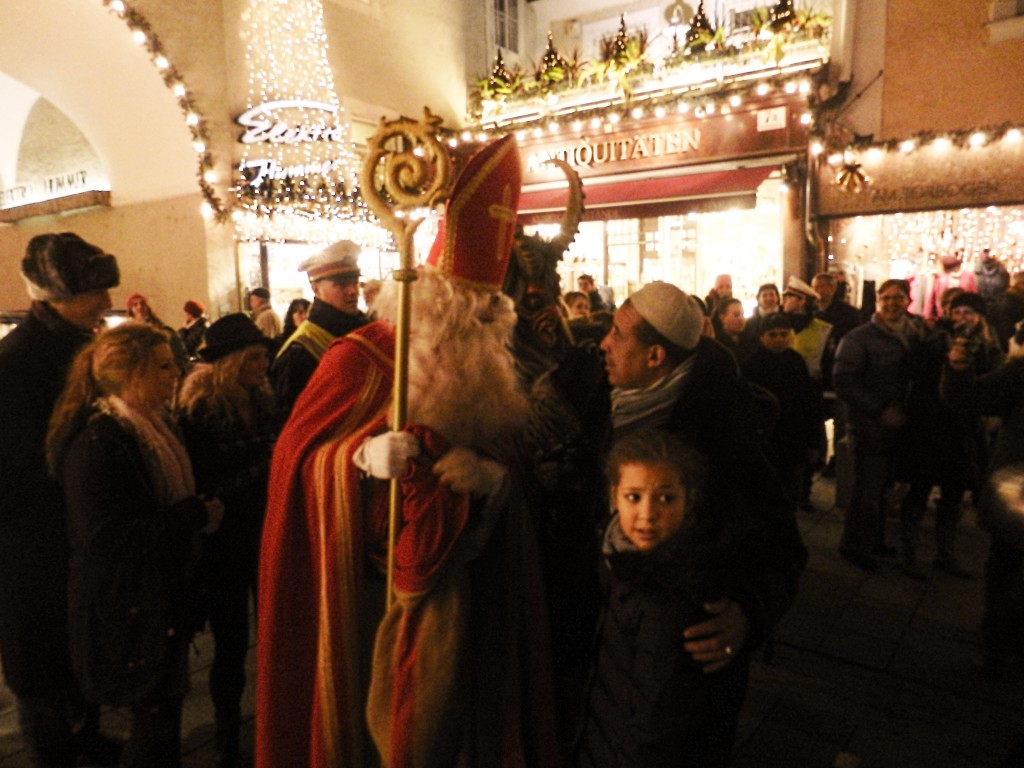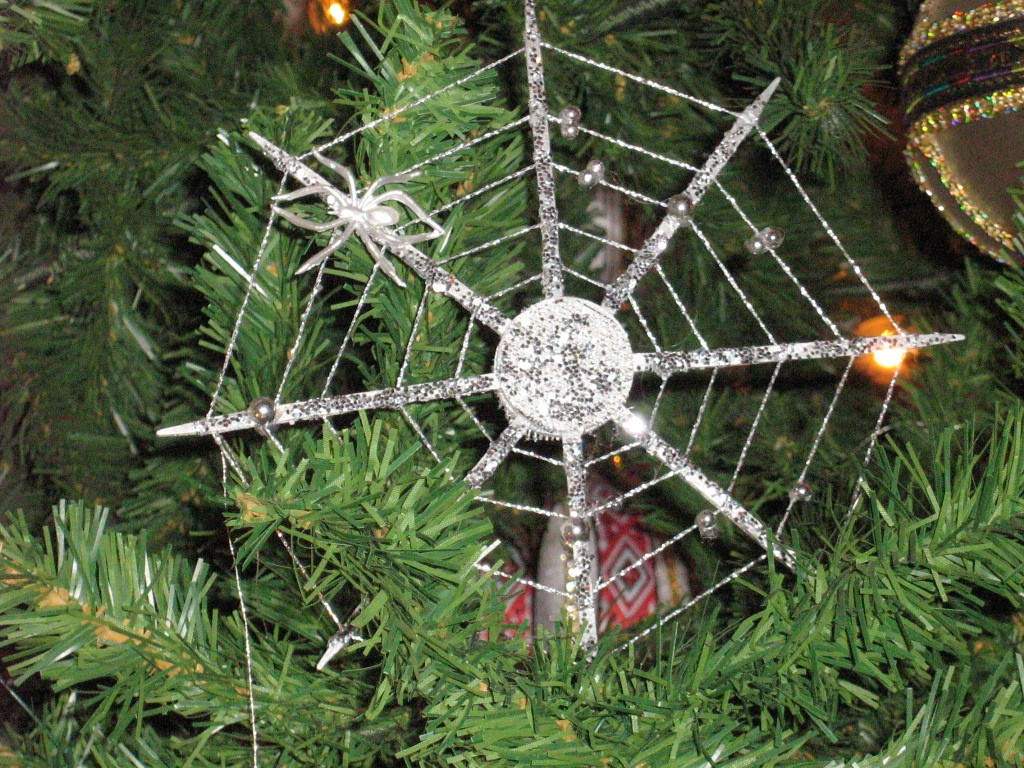Christmas is a popular holiday for many countries around the world, but it doesn’t mean that we all like to celebrate it the same way. In the Ukraine there’s a magic spider who spins golden webs onto the Christmas tree; Italy has a witch who hands out presents via flying broomstick; in Austria lives a hairy, horned hellion who whips naughty children with birch branches. If you think that’s weird, imagine what they think of our North American myth, with our toy-making elves, neon-nosed reindeer and a Coca-Cola Santa Claus. The craziest legends come to life during the Christmas season, some we’ve come to accept and some we know nothing about! So open your mind, let your imagination flow and pretend you’re a child again as we recount Christmas tales from around the world, starting with our very own Old Saint Nick.
North American Santa Claus
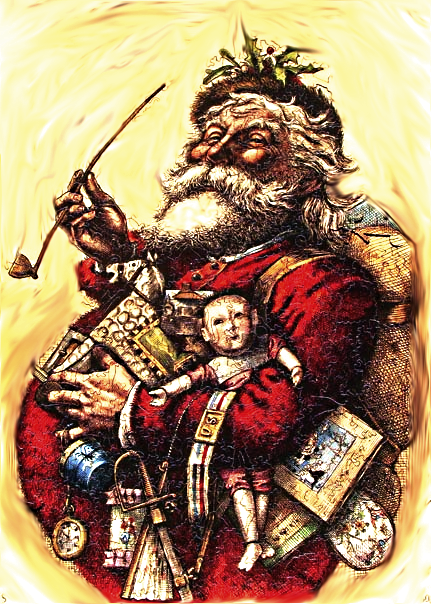
Somewhere hidden in the most northern part of the world lies Santa’s workshop. Whether it be a mighty castle or humble cottage nobody knows, but throughout the year Santa Claus and his team of elf workers are busy crafting toys for deserving children. Santa Claus is not an ordinary man– he has lived for thousands of years and through some miracle he is able to visit every home around the world in a single night. By Christmas eve on December 24th, Santa Claus and his entourage of elven folk have finished crafting billions of Xboxs’, Legos, and My Little Ponies’ for delivery. After loading up his mighty sleigh (able to support over one billion metric tonnes) Santa Claus shackles up his highly energetic team of flying reindeer. Their names are Dasher, Dancer, Prancer, Vixen, Comet, Cupid, Donner, and Blitzen in that specific order, along with a newer addition to the team: Rudolph the Red-Nosed reindeer. Rudolph is at the head of the herd and through stormy weather his radioactive nose lights the way. Throughout the eternal night Santa’s sleigh flies from house to house delivering presents for all the good children, while the dawn waits. Managing to land the sleigh of considerable mass onto roofs without damaging any of the tiles, Santa Clause leaps down the chimney with his sack of toys. To prepare for Santa’s arrival, parents set up and decorate a fir tree with branches wide enough to contain as many presents as possible. Colourful stockings are hung over the fireplace which Santa Claus is obligated to fill with extra goodies. In the past, undeserving or naughty children would get chunks of coal for Christmas, but lately Santa Claus has become somewhat confused, giving the rotten and spoiled children the most presents. To award Santa for giving billions of children homemade Xbox’s for free, a glass of milk and a couple of biscuits are left out to fuel his insurmountable mission, as well as a carrot for his nine flagging reindeer to share. The countless cookies (and a glass of sherry from time to time) that Santa consumes gives him a strapping, full-blooded countenance– he’s fat, in a healthy sort of way. A wreath of cloud follows him everywhere because Santa loves smoking fine-smelling pipe tobacco, which is also good for him. When Santa’s work is finished, the spell of the night breaks and as soon as the sun peeks over the horizon children everywhere, too excited to breath, are ripping into their presents like wolverines.
Dutch Black Pete
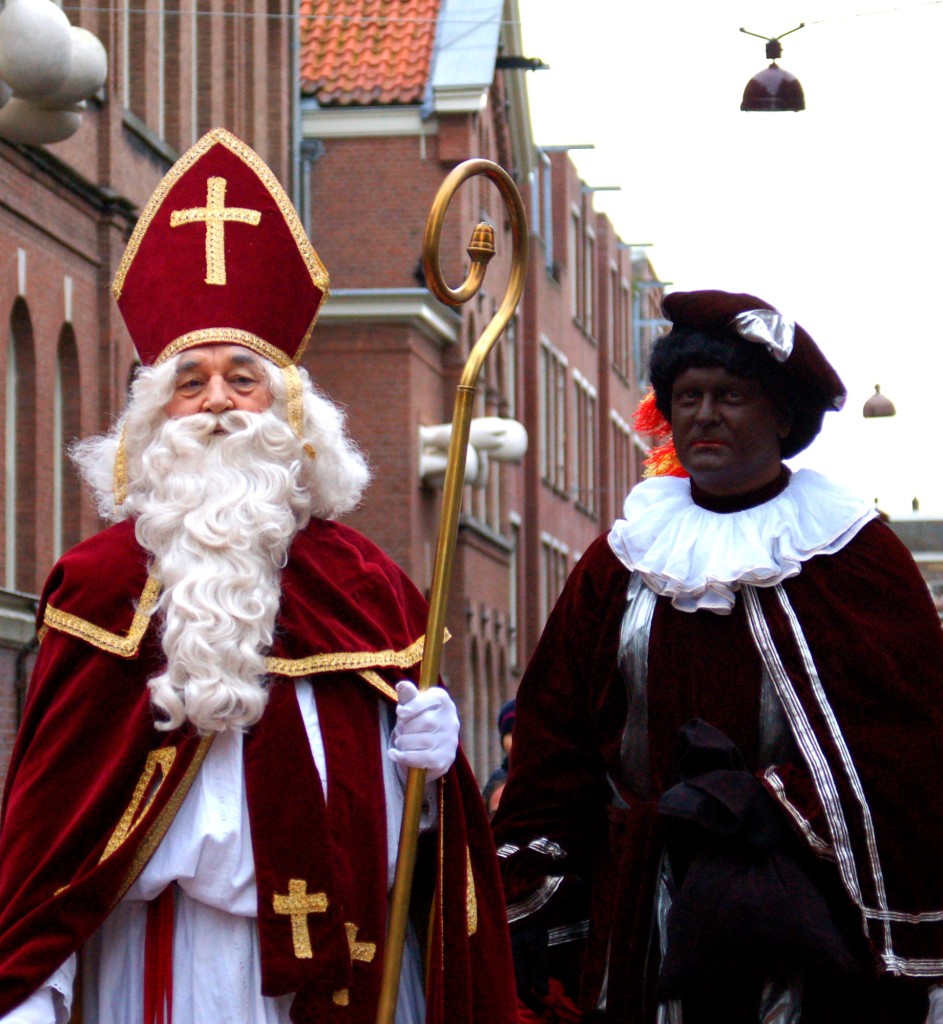
The legend of Santa Claus began in the United States when 17th century Dutch settlers brought over their own Christmas mythology of a ‘Sinter Klaas‘. Sinter Klaas was once ‘Saint Nicholas’, a Greek Bishop of Myra whose legend eventually conceived the persona of Santa Claus. Today the Dutch believe in their original Sinter Klaas, a thinner, less jolly man with a long red cape and a bishop’s hat. On the first Saturday after the 11th of November, Sinter Klaas arrives from his home in Spain (yes, hot and sunny Spain) by steamboat to the Netherlands, laden with gifts and candy. Klaas is always accompanied by his nefarious but reliable assistant, “Zwarte Piet”, who believes that sparing the rod is spoiling the child. While Sinter Klaas gets to be Mr. Nice Guy, Black Pete does all of the saint’s dirty work which includes diving down dirty chimney’s and punishing naughty kids. On the night of Dec.5th, children leave their shoes next to the fireplace filled with hay or carrots for Sinter Klaas’ horse. In the middle of the night, Sinter Klaas comes riding through the air on his white stallion with Zwarte Piet in the back seat. Not wanting to get his bishops’ cloak filthy, Klaas sends his servant down the chimney to retrieve the horse feed and fill the shoes with gifts and candy. If you are a naughty child, Black Pete will instead stuff you into his jute sack and take you back to Spain while Sinter Klaas looks the other way. If you think of Sinter Klaas having a black servant is racist, there’s a perfectly, reasonable explanation. Zwarte Piet is permanently sooty from having to dive down a million chimneys, so he just looks like a black slave.
Austrian Krampus
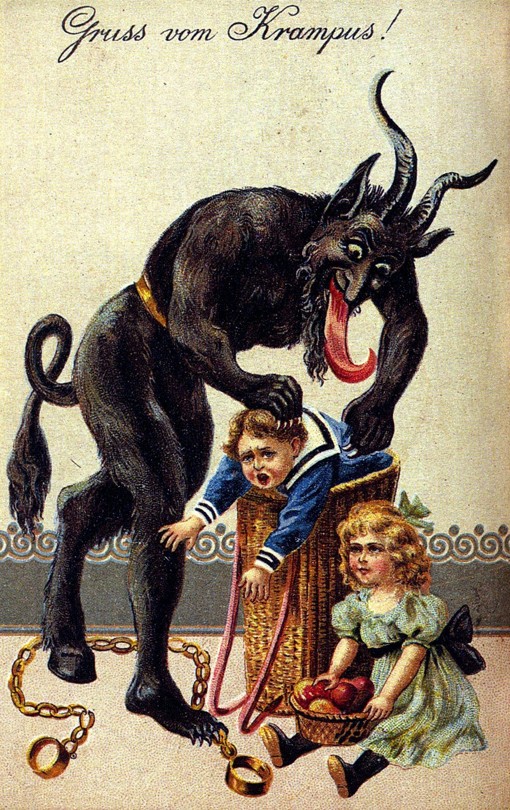
While Sinter Klaas has Zwarte Piet, the Austrian Sankt Nikolaus is accompanied by a horrible beast called the Krampus. Krampus is a seven foot tall, hairy, horned monster that arrives on the night of December the 5th to terrorize innocent civilians. Krampus has one cloven foot, one clawed foot and a tongue that would make Gene Simmons jealous. His name comes from the old German word meaning “claw”, and he is one nasty Christmas creature. Nobody really knows where he came from or how the tradition started; the Krampus could be a demon tamed by the holy power of Saint Nicholas, or he could be the Horned God from ancient, pagan cults. The night before Nikolaus comes to deliver presents on December 6th, the Krampusnaucht occurs when a parade of monsters wander the streets in search of children or blonde-haired women to snare. With cowbells attached to their backs so you can hear them coming, the Krampus ambush innocent civilians with their birch whips and their schauriglustig (scary-funny) antics. While Saint Nicholas only concerns himself with good children, the Krampus is in charge of the bad, giving them coal instead of presents, whipping them with birch branches, or stealing them back to its den for more fun.
French Père Fouettard

Probably the nastiest of the world’s Anti-Claus’ is the French Père Fouettard. Hundreds of years ago, three wealthy boys were on their way to enroll in a religious boarding school. The sun was setting in the evening sky and the lads decided to spend the night in a roadside inn before continuing on to school in the morning. Seeing that they were from a wealthy family, the evil innkeeper plotted to rob the boys of their valuables. After drugging them and stealing their money, Père Fouettard cut their bodies into small pieces and added them to a stew, because there’s no sense in wasting good meat. Through some divine means, Saint Nicholas learns of Fouettard’s horrible deed and magically resurrected the three boys, sending them on their way as if nothing happened. Fearful of the awesome power of Saint Nicholas, Père Fouettard promised to serve him for all eternity. To this day, in France, Saint Nicholas is always accompanied by Father Whipper, a tall, dark and hideous man with a large black beard. While Saint Nicholas awards the good people with gifts, Père Fouettard distributes coal or whips bad children, disciplining the selfish and the lazy.
Icelandic Yule-Trolls
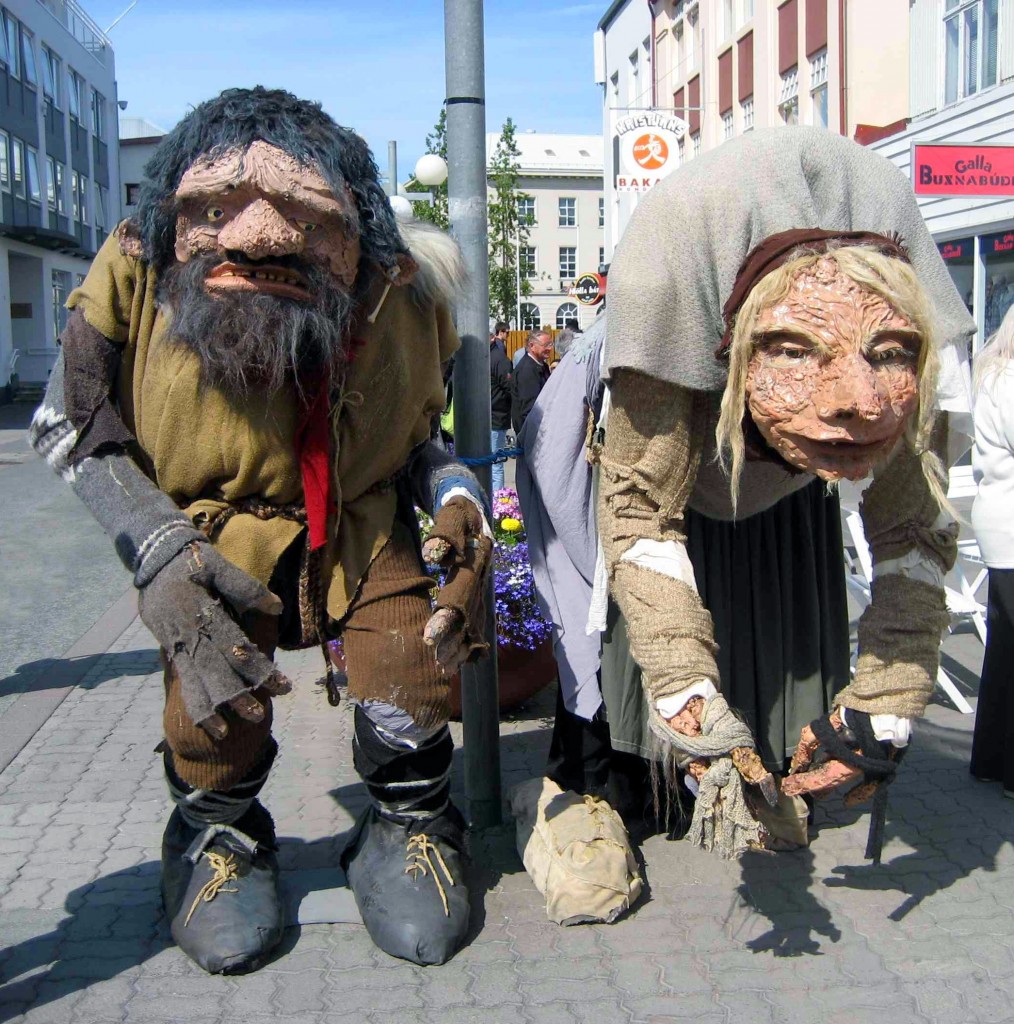 While the French only have Father Whipper to worry about, Icelandic children have to deal with 13 rascal imps who visit them throughout 13 nights of December. These mischievous, Yule-tide lads like to play pranks and steal from unsuspecting villagers during the Christmas season. They are each named after the crimes they commit, for example: Spoon-licker, Sausage-Swiper, Door-Slammer and Window-Peeper are some of their nick-names. From December 12th to the 24th, children leave their shoes on the windowsill and the Yule-lads are sometimes nice enough to place a gift inside, or a rotten potato if they feel like it. While these prankster goblins don’t seem all that bad, their parents are real nasty pieces of work. The trolls Grýla and Leppalúði dwell together in the Dimmuborgir lava fields with their giant, black cat Jólaköttur. These horrible monsters have an insatiable appetite for human flesh, and during the winter festivities they will come in the night to snatch up naughty children for a quick meal.
While the French only have Father Whipper to worry about, Icelandic children have to deal with 13 rascal imps who visit them throughout 13 nights of December. These mischievous, Yule-tide lads like to play pranks and steal from unsuspecting villagers during the Christmas season. They are each named after the crimes they commit, for example: Spoon-licker, Sausage-Swiper, Door-Slammer and Window-Peeper are some of their nick-names. From December 12th to the 24th, children leave their shoes on the windowsill and the Yule-lads are sometimes nice enough to place a gift inside, or a rotten potato if they feel like it. While these prankster goblins don’t seem all that bad, their parents are real nasty pieces of work. The trolls Grýla and Leppalúði dwell together in the Dimmuborgir lava fields with their giant, black cat Jólaköttur. These horrible monsters have an insatiable appetite for human flesh, and during the winter festivities they will come in the night to snatch up naughty children for a quick meal.
Greek Killantzaroi Spirits
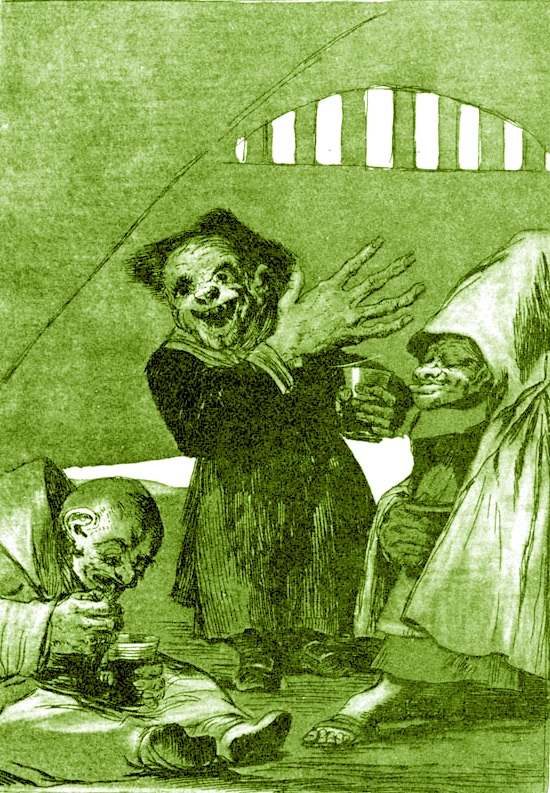
The Greeks are harassed by their own type of goblins called Killantzaroi. Instead of setting up a Christmas tree in their living room, the Greek’s main symbol of the holidays is a shallow, wooden bowl with a piece of wire suspended across the rim. A sprig of basil wrapped around a wooden cross hangs from the wire and a small amount of water is kept in the bowl to keep the basil fresh. Every day between Christmas and January 6th, somebody must dip the cross into holy water and sprinkle it in every room of their house. By blessing their homes, the Greeks are able to repel the devious Killantzaroi goblins that would otherwise swarm in through the chimney and create havoc in the house. It is said that the Killantzaroi are extremely ugly, evil spirits that emerge from the centre of the earth during the twelve days of Christmas to cause mischief. Not being particularly bright, they are only known to have committed silly crimes like riding on people’s backs, braiding horse’s tails, and souring the milk, so they’re not altogether dangerous. It is also a Greek tradition to keep the fireplace lit throughout the twelve days of Christmas so that the little imps can’t come down the chimney.
Ukrainian Magic Spider
With Greece being an exception, the Christmas Tree is a major symbol of the Christmas season. For hundreds of years this live fir has been brought in from the winter cold, set up and decorated with shiny baubles and colourful trinkets to add life to the winter gloom. In Ukraine fake spider webs often adorn their tree, an unusual tradition carried on from an old legend when a poor family witnessed a Christmas miracle. Long ago there lived a widow and her kids in a tiny shack. The family was very poor and Christmas was always a sad time for the mother because she could never afford any gifts for her children. Every Christmas the family could hear their neighbours enjoying a feast and gleefully exchanging presents, but all they could do was dream of better times. One day a pine cone dropped onto their land and the children were excited because they would soon have a young tree to decorate for Christmas. By the time it grew to the appropriate size the family still had nothing to decorate the tree with, and on Christmas Eve they went to bed knowing that, yet again, they would have an empty Christmas. During the night, a strange thing happened. Hundreds of spiders climbed into the tree and spun webs throughout its branches. In the morning, the children shrieked with glee because as the sun rose the spider webs transformed into strings of silver and gold. The widow and her children were poor no longer, and from that day on they never wanted for anything.
Italian La Befana
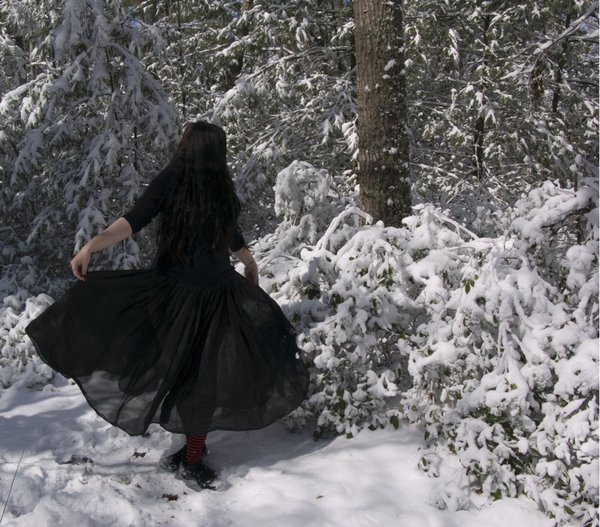
During the Christmas season, countries around the world are visited by various creatures of the night, good or bad, and Italy is no exception. There is a tale of a Lady Befana, a widow who lived alone in a house in the hills of Italy. Because her husband and children had passed away, she often occupied her time with chores, baking and hard work. One clear evening, La Befana noticed a bright star in the night sky, but with her mind occupied with her chores she thought nothing of it. That very same evening, a large caravan pulled up outside her house and three illustrious men came to her door asking directions to Bethlehem, for they were on a journey to witness the birth of the Christ child. These three kings offered for Lady Befana to join them on their mission, but Befana knew nothing of this far off place and was too busy to care. While watching the caravan disappear behind the hills in the direction of the bright star, Befana thought of how much she missed her own child, who died at a very young age, and decided she would like to meet this baby Jesus. Gathering baked goods and gifts for the new baby, and grabbing her trusty broom to help clean up for the new mother, La Befana set off on an adventure to find the Christ child. After following the magic star for many days the the widow became too weary to continue. She was about to give up hope when an angel miraculously appeared from out of the magic star and flew down to her. Grasping Befana’s old broom, the angel blessed it with the power of flight to speed her on her way. Giving praise to God, La Befana leapt upon the magic broomstick and soared off into the night sky in search of the baby Jesus. It is said that to this day, La Befana searches for Jesus Christ on board her flying broomstick, stopping into every home to look for him and leaving a gift for any child she finds. On the eve of January 6th, children all over Italy wait expectantly for the good witch who’ll bring them presents, and they sing:
La Befana vien di notte
Con le scarpe tutte rotte
Col vestito da romana
Viva viva la Befana!
The Befana comes at night
In worn out shoes
Dressed like a Roman
Long live the Befana!
Every year, beyond the frozen wastes outside our cozy homes, magical creatures spring to life: benevolent spirits to reward the righteous and horrible beasts to punish the wicked. Though Christmas is the season for wild celebration and family love, it is also the time for childhood wonderment, that hope for magic and miracles. You can still feel it, can’t you, when you look out through snowflakes gently falling in the darkness, when the candle flame flickers uneasy shadows in the hall. The stories you read to your children awaken dreams that were once so real and on those quiet, Christmas evenings, the whole world watchfully waits for the Santa Claus.
